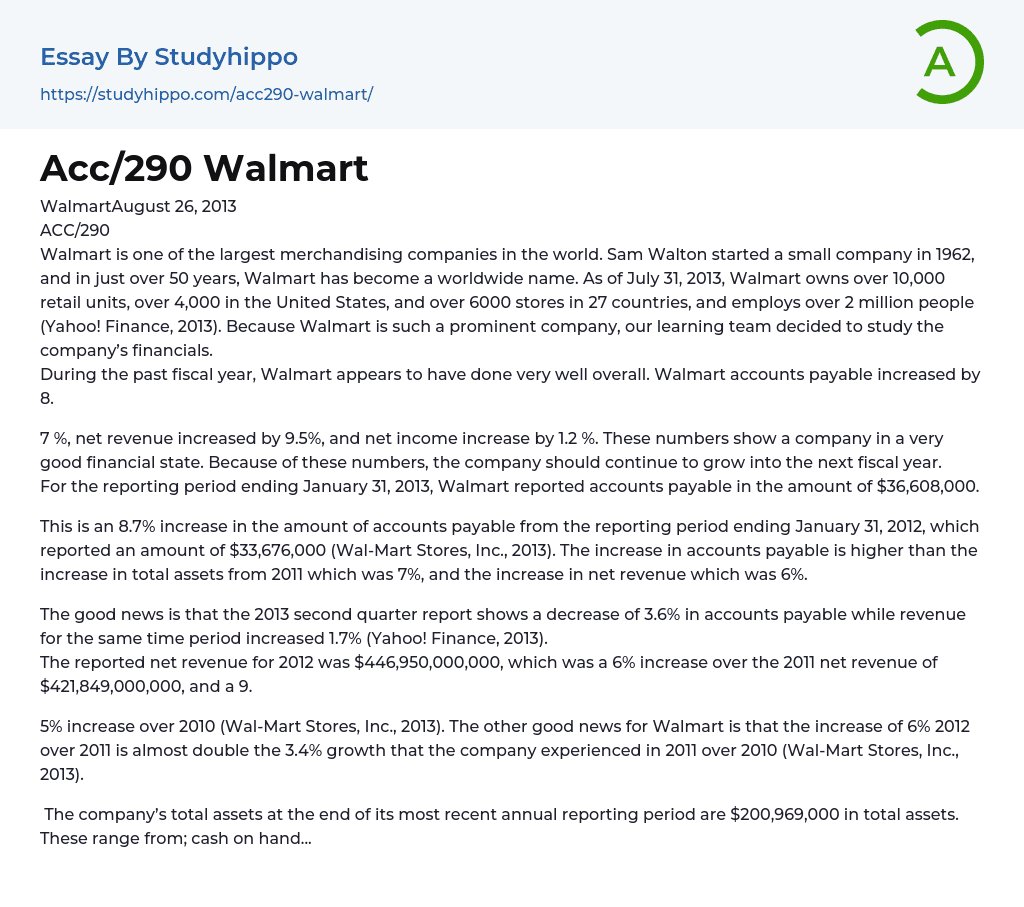Walmart is one of the largest merchandising companies in the world. Sam Walton started a small company in 1962, and in just over 50 years, Walmart has become a worldwide name. As of July 31, 2013, Walmart owns over 10,000 retail units, over 4,000 in the United States, and over 6000 stores in 27 countries, and employs over 2 million people (Yahoo! Finance, 2013). Because Walmart is such a prominent company, our learning team decided to study the company’s financials.
During the past fiscal year, Walmart appears to have done very well overall. Walmart accounts payable increased by 8.7 %, net revenue increased by 9.5%, and net income increase by 1.2 %. These numbers show a company in a very good financial state. Because of these numbers, the company should continue to grow into the next fiscal year.
For the reporting peri
od ending January 31, 2013, Walmart reported accounts payable in the amount of $36,608,000.
This is an 8.7% increase in the amount of accounts payable from the reporting period ending January 31, 2012, which reported an amount of $33,676,000 (Wal-Mart Stores, Inc., 2013). The increase in accounts payable is higher than the increase in total assets from 2011 which was 7%, and the increase in net revenue which was 6%.
The good news is that the 2013 second quarter report shows a decrease of 3.6% in accounts payable while revenue for the same time period increased 1.7% (Yahoo! Finance, 2013).
The reported net revenue for 2012 was $446,950,000,000, which was a 6% increase over the 2011 net revenue of $421,849,000,000, and a 9.5% increase over 2010 (Wal-Mart Stores, Inc., 2013). The other good news for Walmart is that the
increase of 6% 2012 over 2011 is almost double the 3.4% growth that the company experienced in 2011 over 2010 (Wal-Mart Stores, Inc., 2013).
The company’s total assets at the end of its most recent annual reporting period are $200,969,000 in total assets. These range from; cash on hand...
- Money essays
- Financial Accounting essays
- Market Segmentation essays
- Supply And Demand essays
- Purchasing essays
- Forecasting essays
- Legacy essays
- Bank essays
- Corporate Finance essays
- Financial News essays
- Financial Ratios essays
- Financial Services essays
- Free Market essays
- Shareholder essays
- Personal finance essays
- Equity essays
- Financial Crisis essays
- Banking essays
- Credit Card essays
- Currency essays
- Debt essays
- Gold essays
- Loan essays
- Enron Scandal essays
- Foreign Exchange Market essays
- Investment essays
- Venture Capital essays
- Stock Market essays
- Retirement essays
- Donation essays
- Net Present Value essays
- Income Statement essays
- Commercial Bank essays
- Debit Card essays
- Deposit Account essays
- Subprime Lending essays
- Perfect Competition essays
- Underwriting essays
- Synergy essays
- Valuation essays
- Investing essays
- Asset essays
- Depreciation essays
- Discounted Cash Flow essays
- Foreign Direct Investment essays
- Funds essays
- Internal Rate Of Return essays
- Revenue essays
- Day Trading essays
- Futures Trading essays




